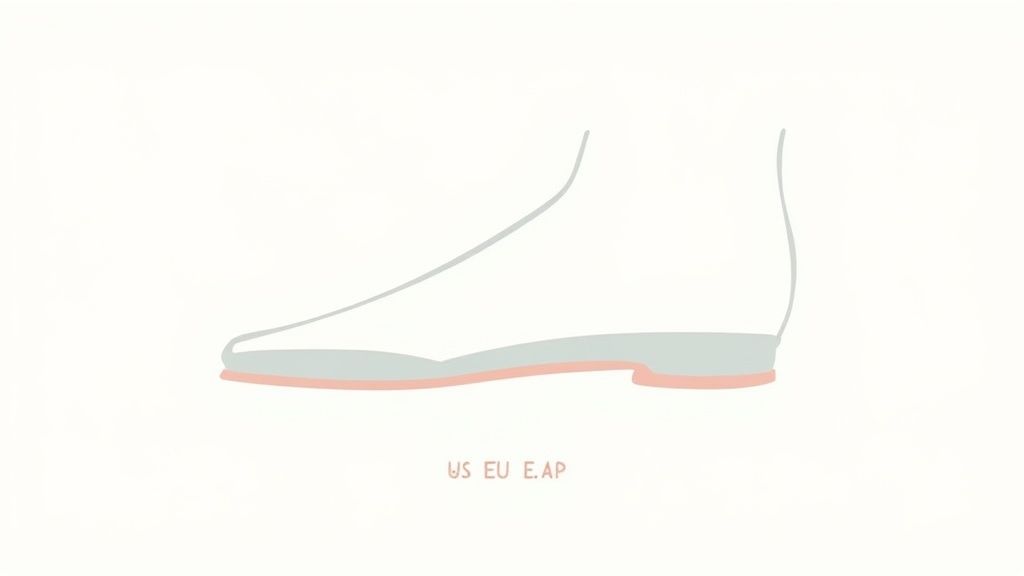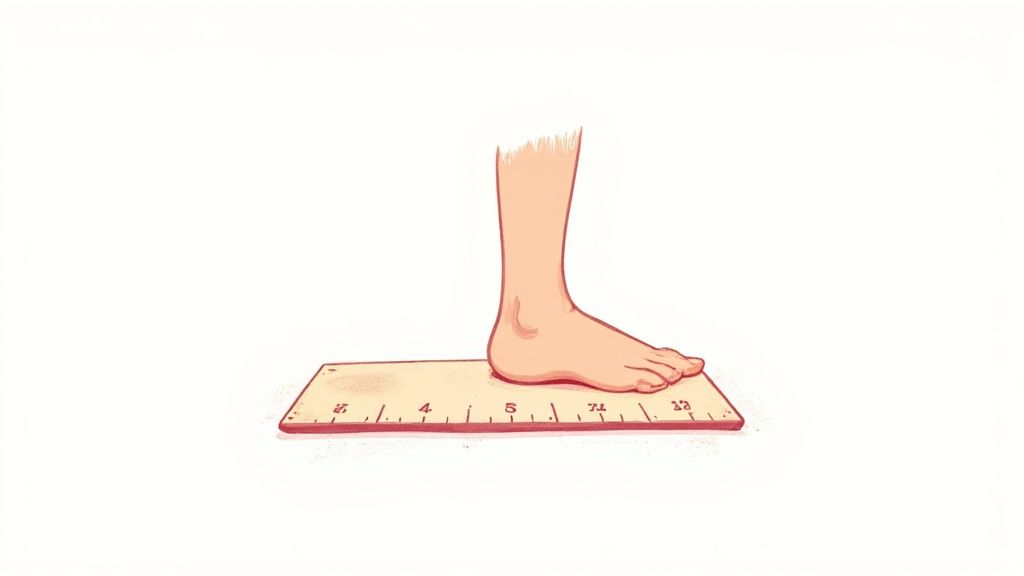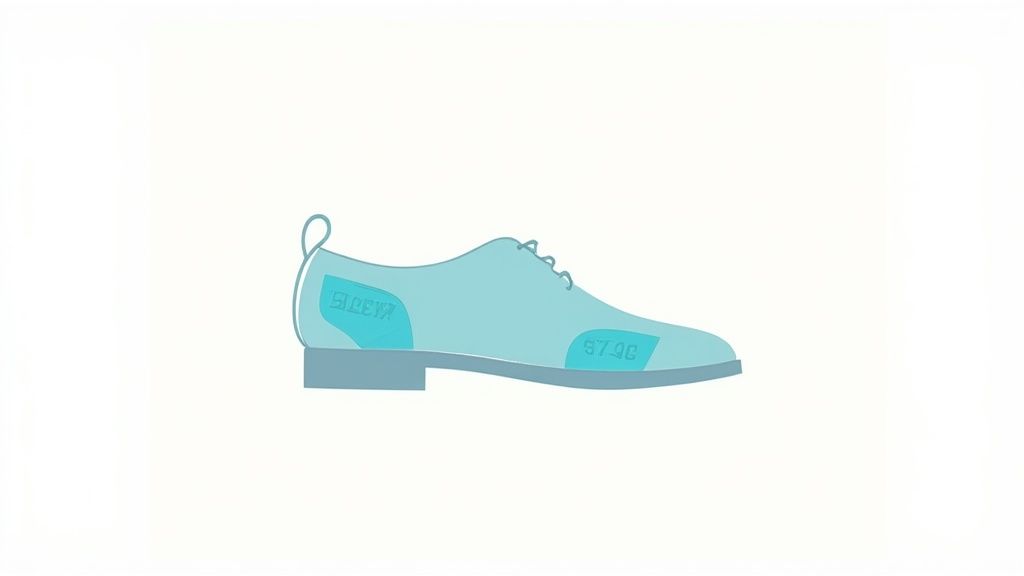Getting the right insole size shouldn't be a guessing game. A good insole size chart is your best tool, acting as a translator between your shoe size—whether it's US, UK, or EU—and the specific insole you need. This is the key to unlocking real comfort and support.
Your Quick Guide to Insole Sizing

While your shoe size is a helpful starting point, it's not the whole story. We've all experienced how sizes can differ wildly from one brand to another. That’s why the most accurate way to find your perfect fit is to measure your foot directly.
A proper fit is about more than just length. It ensures the insole’s built-in arch support and heel cup line up exactly where your foot needs them. This precise alignment is what allows the insole to distribute pressure correctly and do its job, which is especially important if you're dealing with issues like plantar fasciitis.
To make things easy, here’s a quick-reference table. It’s designed to help you find your recommended insole size in seconds.
Insole Size Conversion At a Glance
| US Men's Size | US Women's Size | UK Size | EU Size | Foot Length (CM) | Recommended Insole Size |
|---|---|---|---|---|---|
| 4-4.5 | 5.5-6 | 3.5-4 | 36-36.5 | 22.2-22.5 | XS |
| 5-5.5 | 6.5-7 | 4.5-5 | 37-37.5 | 22.9-23.2 | XS |
| 6-6.5 | 7.5-8 | 5.5-6 | 38-38.5 | 23.8-24.1 | S |
| 7-7.5 | 8.5-9 | 6.5-7 | 39-40 | 24.8-25.1 | S |
| 8-8.5 | 9.5-10 | 7.5-8 | 41-41.5 | 25.7-26.0 | M |
| 9-9.5 | 10.5-11 | 8.5-9 | 42-42.5 | 26.7-27.0 | M |
| 10-10.5 | 11.5-12 | 9.5-10 | 43-44 | 27.6-27.9 | L |
| 11-11.5 | 12.5-13 | 10.5-11 | 44.5-45 | 28.6-28.9 | L |
| 12-12.5 | - | 11.5-12 | 45.5-46 | 29.6-29.9 | XL |
| 13-13.5 | - | 12.5-13 | 46.5-47 | 30.2-30.5 | XL |
| 14-15 | - | 13.5-14 | 48-49 | 31.1-31.8 | XXL |
| 16-17 | - | 15-16 | 50-51 | 32.7-33.3 | XXL |
Use this table as your go-to guide for matching your shoe size or foot measurement to the correct insole, setting you on the path to better foot health and comfort.
Why Getting the Right Insole Size is So Important

Picking the right insole goes way beyond just feeling comfortable—it's absolutely essential for your foot health and how your body moves. An insole that doesn't fit well can honestly cause more problems than it solves. It might create new pressure points or completely miss the areas that need support, which can either trigger or aggravate issues like plantar fasciitis, arch pain, and overpronation.
Think about it: if an insole is too big, it's going to bunch up in your shoe, leading to blisters and constant annoyance. On the other hand, if it's too small, its key features—like the arch support or the heel cup—won't line up correctly with your foot. This misalignment makes the insole pretty much useless and can put extra strain on your feet, ankles, and even your knees.
How Sizing Affects Support and Performance
The whole point of a good insole is to support and position your foot correctly. For that to work, every curve and contour of the insole has to line up perfectly with the unique shape of your foot.
- Arch Support: The right size means the arch support sits exactly where it should be—right under your natural arch. This gives you the stability you need to prevent your arch from collapsing. You can learn more about how the right arch support can make a difference in our detailed guide.
- Heel Stability: The heel cup needs to cradle your heel snugly. This helps control motion and cuts down on the instability that often leads to pain.
Getting the size right isn't just a suggestion; it's non-negotiable if you want real pain relief and better performance. A perfect fit is what turns a simple shoe insert into a powerful tool for your body's mechanics.
The demand for high-quality athletic insoles is booming, with the market expected to hit an incredible USD 18.9 billion by 2035. This huge number just goes to show how many people, from everyday walkers to dedicated athletes, are realizing the importance of a proper fit. Having a reliable insole size chart is more critical than ever.
How to Measure Your Feet Accurately

While a good conversion table is a fantastic shortcut, nothing beats measuring your own feet for a truly accurate fit. Shoe sizes can be all over the place depending on the brand, but your foot length? That’s a number you can rely on.
The best part is you don't need any fancy equipment. A simple piece of paper, a pencil, and a ruler are all it takes to get it right. Taking a few minutes to do this cuts out the guesswork and ensures your new insoles deliver the support you expect.
Your Step-by-Step Measuring Guide
Getting a precise measurement is easy. Just follow these steps, and you’ll have the exact number you need for a perfect fit.
- Prep Your Surface: Grab a sheet of paper and place it on a hard, flat floor. Steer clear of carpets or rugs, as the soft surface can throw off your measurement.
- Trace Your Foot: Stand with one foot placed firmly on the paper. It's crucial to be standing, as your body weight naturally causes your foot to spread and lengthen. Holding a pencil perfectly upright, carefully trace the outline of your foot.
- Measure the Length: Take your ruler and measure the tracing from the back of the heel to the tip of your longest toe.
- Do the Other Foot: Believe it or not, most people have feet that are slightly different sizes. Repeat the process for your other foot to see if there's a difference.
- Use the Larger Measurement: Always go with the measurement from your larger foot. This simple trick prevents your insole from being uncomfortably short for one of your feet.
Pro Tip: Measure your feet at the end of the day. They naturally swell after you've been on them for hours, so measuring in the evening will give you the most realistic size. This ensures your insoles won't feel tight when your feet are at their largest.
The Complete Insole Size Chart

Alright, you've got your foot measurement. Now what? This is where the magic happens. The insole size chart below is your new best friend for finding that perfect fit. It's designed to cut through the confusion of different sizing systems—US Men's, US Women's, UK, and EU—by connecting them to the one number that truly matters: your foot length in centimeters.
Think of this as your personal conversion tool. Just find your foot length in the first column and trace it across to see the corresponding shoe sizes and, most importantly, the exact insole size you need. It's that simple.
Why Your Foot Measurement Is King: We’ve all been there. You're a size 10 in one brand, but a size 11 in another. Shoe sizes can be wildly inconsistent across manufacturers. That’s why just using your shoe size to pick an insole is a recipe for a bad fit. Your actual foot length, however, doesn't lie. It’s the reliable, constant measurement you need for a truly custom-feeling fit.
Comprehensive Insole Size Conversion Chart
This table is your go-to reference. You can easily cross-check your measurement against standard international sizes. For the best possible results with your Samurai Insoles, always defer to your measurement in centimeters.
| Foot Length (CM) | US Men's Size | US Women's Size | UK Size | EU Size | Suggested Insole Size |
|---|---|---|---|---|---|
| 22.2 - 22.5 | 4 - 4.5 | 5.5 - 6 | 3.5 - 4 | 36 - 36.5 | XS |
| 22.9 - 23.2 | 5 - 5.5 | 6.5 - 7 | 4.5 - 5 | 37 - 37.5 | XS |
| 23.8 - 24.1 | 6 - 6.5 | 7.5 - 8 | 5.5 - 6 | 38 - 38.5 | S |
| 24.8 - 25.1 | 7 - 7.5 | 8.5 - 9 | 6.5 - 7 | 39 - 40 | S |
| 25.7 - 26.0 | 8 - 8.5 | 9.5 - 10 | 7.5 - 8 | 41 - 41.5 | M |
| 26.7 - 27.0 | 9 - 9.5 | 10.5 - 11 | 8.5 - 9 | 42 - 42.5 | M |
| 27.6 - 27.9 | 10 - 10.5 | 11.5 - 12 | 9.5 - 10 | 43 - 44 | L |
| 28.6 - 28.9 | 11 - 11.5 | 12.5 - 13 | 10.5 - 11 | 44.5 - 45 | L |
| 29.6 - 29.9 | 12 - 12.5 | -- | 11.5 - 12 | 45.5 - 46 | XL |
| 30.2 - 30.5 | 13 - 13.5 | -- | 12.5 - 13 | 46.5 - 47 | XL |
| 31.1 - 31.8 | 14 - 15 | -- | 13.5 - 14 | 48 - 49 | XXL |
| 32.7 - 33.3 | 16 - 17 | -- | 15 - 16 | 50 - 51 | XXL |
When you use this chart, you're making sure the insole’s key features—like the arch support and heel cup—line up exactly where they should. This precision is what leads to maximum comfort and real results.
Understanding Different Insole Types
Getting the size right is crucial, but it's only half the battle. To really get the most out of your insoles, you need to match the type of insole to your specific needs. Are you looking for serious pain relief, a boost in athletic performance, or just a little extra cushion for your daily walk?
Let's break down the main categories you'll encounter.
The Main Insole Categories
-
Orthotic Insoles: Think of these as therapeutic tools for your feet. They are specifically engineered with features like firm arch support and a deep, structured heel cup. The goal is to correct biomechanical problems—like overpronation—which is often the root cause of conditions like plantar fasciitis. With orthotics, precise sizing isn't just a suggestion; it's essential for the corrective components to align with your foot's structure and do their job properly.
-
Athletic Insoles: These are all about performance and protection. Built for high-impact activities, they focus on absorbing shock and providing energy return to reduce stress on your joints when you run, jump, and play.
-
Comfort Insoles: If you're just looking to add a layer of softness to your shoes, this is your category. Usually made from gel or foam, they provide general cushioning. While they make your shoes feel more comfortable, they don't offer the structured support needed to fix underlying foot issues.
The global orthotic insoles market is on track to hit USD 5.78 billion by 2030, which really speaks to how vital they've become for foot health. This surge underscores the need for reliable sizing tools, like a good insole size chart, so people can actually get the relief they're paying for. You can dive deeper into these numbers in this detailed report on orthotics statistics.
In the end, knowing what you want your insoles to accomplish is the key. To help you zero in on the perfect pair for your feet and your goals, take a look at our guide on how to choose the right insoles.
Common Sizing Mistakes to Avoid
Picking the right insole can feel a bit like guesswork, but you can sidestep a lot of frustration by avoiding a few common pitfalls. The single biggest mistake we see? People assuming their shoe size is their insole size. It's an easy assumption to make, but because sizing varies so much from one shoe brand to another, it almost always leads to a poor fit.
Another classic error is measuring only one of your feet. It might sound strange, but most of us have one foot that's slightly larger than the other. Always, always use the measurement from your larger foot. This guarantees you'll have enough room and comfort for both feet.
Insole Thickness and Shoe Volume
Finally, you have to think about the insole's thickness and how it will fit inside your shoe. A super thick, plush insole can feel amazing, but it can also cramp your foot and make your shoes uncomfortably tight if there isn't enough space.
For shoes that are already snug, like dress shoes, cycling shoes, or soccer cleats, you'll want to go with a thinner insole. If you need a hand with this, our guide on how to choose the best insoles for your shoes breaks it all down.
With the global shoe insoles market valued at an impressive USD 5.97 billion in 2023, getting the right information is more important than ever. A solid insole size chart is your best tool for steering clear of these common mistakes and finding an insole that actually fits and feels good. You can read more about the growing shoe insole market on grandviewresearch.com to see just how big this industry is.
Got Sizing Questions? We’ve Got Answers.
When you're trying to find the right insoles, a few questions always seem to pop up. That's completely normal. Getting the right fit is the most important step for getting real relief, so let’s clear up the common sticking points.
A question we hear all the time is: “Should my insoles be the exact same size as my shoes?” It seems logical, but the answer is almost always no. Shoe sizes can be all over the map depending on the brand, which is why we always recommend using your actual foot measurement and our insole size chart. It’s simply the most reliable way to get it right.
What If I’m Between Sizes?
This happens a lot, so don't worry. If your foot measurement lands you squarely between two sizes, the golden rule is to always size up.
Why? You can easily trim a little extra material off an insole that's slightly too big, but you can’t add length to one that's too small. A short insole means the arch support and heel cup won't line up with your foot correctly, defeating the whole purpose.
For instance, if your foot is 27.3 cm long, you're right between a Medium and a Large on our chart. Go with the Large. This ensures the supportive parts of the insole are exactly where they need to be.
Key Takeaway: When in doubt, go for the larger size. It gives you the wiggle room to create a custom fit without sacrificing the insole's support.
Can I Trim My Insoles for a Better Fit?
Yes, absolutely! In fact, most full-length insoles are made to be trimmed. This is how you get that perfect, custom-like fit inside your specific shoes.
Here's the best way to do it:
- Start by pulling out the original, flimsy insole that came with your shoe.
- Lay it directly on top of your new insole. Make sure you line up the heels perfectly.
- Use a pen or marker to trace the outline of the original insole onto your new one.
- With a good pair of scissors, carefully cut along the line you just drew.
This quick trick ensures your new insole will slide into place without any annoying bunching or slipping.
Ready to stop guessing and start feeling real relief? Samurai Insoles are designed with biomechanical precision to tackle overpronation and foot pain. Find your perfect fit today and take the first step toward lasting comfort.



